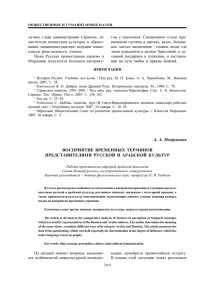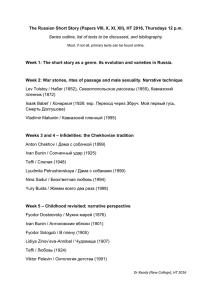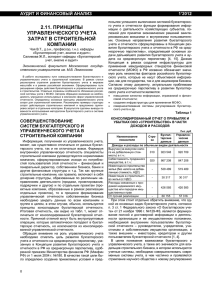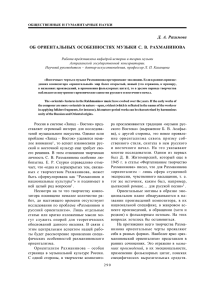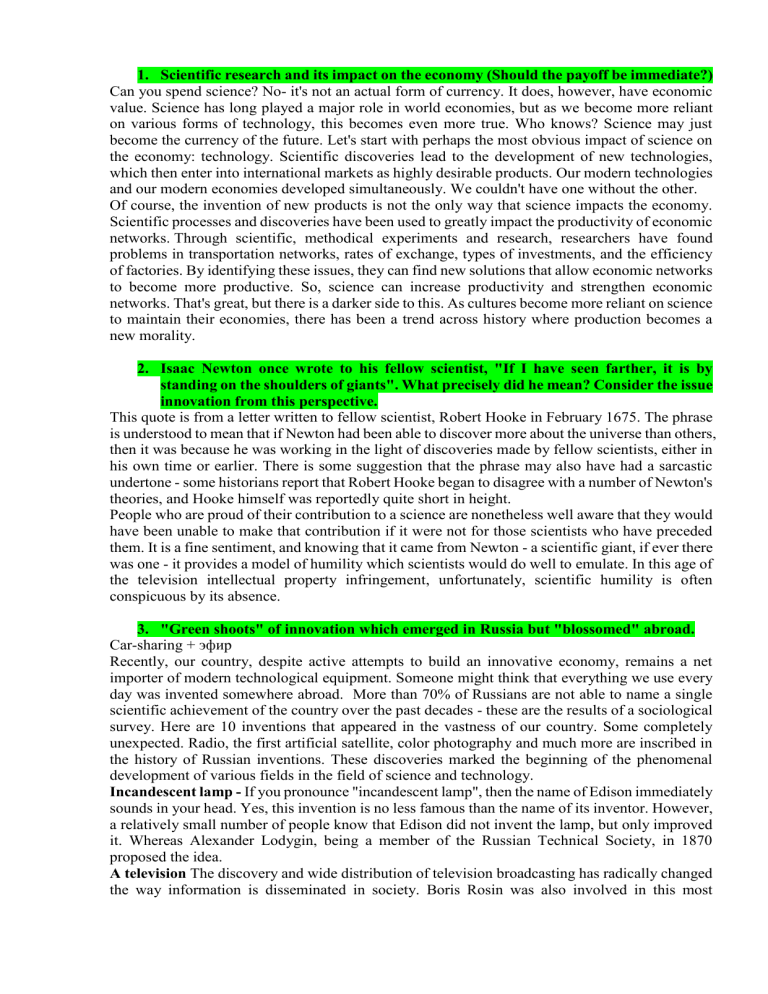
1. Scientific research and its impact on the economy (Should the payoff be immediate?) Can you spend science? No- it's not an actual form of currency. It does, however, have economic value. Science has long played a major role in world economies, but as we become more reliant on various forms of technology, this becomes even more true. Who knows? Science may just become the currency of the future. Let's start with perhaps the most obvious impact of science on the economy: technology. Scientific discoveries lead to the development of new technologies, which then enter into international markets as highly desirable products. Our modern technologies and our modern economies developed simultaneously. We couldn't have one without the other. Of course, the invention of new products is not the only way that science impacts the economy. Scientific processes and discoveries have been used to greatly impact the productivity of economic networks. Through scientific, methodical experiments and research, researchers have found problems in transportation networks, rates of exchange, types of investments, and the efficiency of factories. By identifying these issues, they can find new solutions that allow economic networks to become more productive. So, science can increase productivity and strengthen economic networks. That's great, but there is a darker side to this. As cultures become more reliant on science to maintain their economies, there has been a trend across history where production becomes a new morality. 2. Isaac Newton once wrote to his fellow scientist, "If I have seen farther, it is by standing on the shoulders of giants". What precisely did he mean? Consider the issue innovation from this perspective. This quote is from a letter written to fellow scientist, Robert Hooke in February 1675. The phrase is understood to mean that if Newton had been able to discover more about the universe than others, then it was because he was working in the light of discoveries made by fellow scientists, either in his own time or earlier. There is some suggestion that the phrase may also have had a sarcastic undertone - some historians report that Robert Hooke began to disagree with a number of Newton's theories, and Hooke himself was reportedly quite short in height. People who are proud of their contribution to a science are nonetheless well aware that they would have been unable to make that contribution if it were not for those scientists who have preceded them. It is a fine sentiment, and knowing that it came from Newton - a scientific giant, if ever there was one - it provides a model of humility which scientists would do well to emulate. In this age of the television intellectual property infringement, unfortunately, scientific humility is often conspicuous by its absence. 3. "Green shoots" of innovation which emerged in Russia but "blossomed" abroad. Car-sharing + эфир Recently, our country, despite active attempts to build an innovative economy, remains a net importer of modern technological equipment. Someone might think that everything we use every day was invented somewhere abroad. More than 70% of Russians are not able to name a single scientific achievement of the country over the past decades - these are the results of a sociological survey. Here are 10 inventions that appeared in the vastness of our country. Some completely unexpected. Radio, the first artificial satellite, color photography and much more are inscribed in the history of Russian inventions. These discoveries marked the beginning of the phenomenal development of various fields in the field of science and technology. Incandescent lamp - If you pronounce "incandescent lamp", then the name of Edison immediately sounds in your head. Yes, this invention is no less famous than the name of its inventor. However, a relatively small number of people know that Edison did not invent the lamp, but only improved it. Whereas Alexander Lodygin, being a member of the Russian Technical Society, in 1870 proposed the idea. A television The discovery and wide distribution of television broadcasting has radically changed the way information is disseminated in society. Boris Rosin was also involved in this most powerful achievement, who in July 1907 filed an application for the invention of the "Method of electrical transmission of images over distances." Artificial heart / Tetris 4. Bureaucratic vs. flat organizational structure from the perspective of innovation. Organizational structure refers to the way an organization establishes authority, responsibility and communication within the organization. It defines reporting relationships, lines of authority, job positions and responsibilities, and reflects an organization's environment and culture. Bureaucratic and flat organizational structures are two of the most common types of organizational structures. As the name suggests, bureaucratic organizational structure has many levels and hierarchies. Flat organizational charts are more compressed. Bureaucratic organizations assign individuals specialized duties and routinely monitor their performance to ensure consistency. Communication within a bureaucratic structure is formal and commonly relies on written messages, reports and memos. Flatter organizations, on the other hand, hold that flexibility and autonomy are more effective in realizing organizational goals. Flat organizations are more unstructured and encourage employees to be creative and find out-of-the-box solutions for problems. Communication in flat organizations is informal and much of it entails face-to-face meetings. In a flat organizational structure, only one or two approvals are usually necessary and this speed allows new products and services to be implemented faster and with less red tape. Speed increases with fewer levels of management. 5. The advantages of a hierarchical structure in the sphere of innovation. Like most organizational structures, hierarchies have advantages and disadvantages; some of those depend on context. What might be an advantage for one business could be a disadvantage for another, based on the needs and goals of each organization. Advantage: Clear Line of Authority Using a hierarchical structure establishes clear authority for work and departments. Managers have authority according to management level and have the power to allocate resources, reward and punish behavior and give orders to their subordinates. This is an especially useful characteristic during a crisis, when decision-by-committee or subordinate hesitation could be disastrous. The boss gives an order and can expect compliance. Advantage: Clear Lines of Communication The lines establishing the relationships between managers and subordinates also provide communication direction. This approach gives departments a clear spokesperson: the manager. Subordinates know whom to report to and where to get information and directives. This serves to unify the department, resulting in coordination between its members. Advantage: Clear Results When organizing employees according to a hierarchy, it makes sense to organize them by job category. This allows employees doing similar job tasks to share the resources allocated by managers and for managers to coordinate similar efforts for great effect. This grouping sets the stage for efficient operations and cost savings through economies of scale. No overload for employees 6. How to attract and retain the talent (The most effective forms of motivation and reward). Let's face it, most likely there are other companies out there just like yours. So, what do you do to set your organization apart from the herd? Throwing more money at this challenge just doesn't cut it. The best talent out there will be considering several options. Yes, a higher salary helps but it's only a small piece of the puzzle, especially with today's generation entering the workforce. 1. Leadership New job candidates want to know who they are going to be working for and aligning themselves with. The founders. Senior executives. Managers. Anyone with authority. That means you need great leadership that exhibits integrity and upholds the values of the company on and off the battlefield. 2. Career Growth Being able to show candidates where they can go and how they get there is critical. You also have to prove that you can provide the right resources for professional development. Lacking in this area will ensure high turnover. 5. Giving Back Philanthropy and community outreach is a great way to show that your organization believes in causes bigger than itself. That it cares about things more important than revenue and profit. 9. Recognition and Reward Rewards and recognition must be both intrinsic and extrinsic. Extrinsic motivation involves public recognition and external rewards such as bonuses and praise. Intrinsic motivation is even more important. This allows employees to feel connected, like they are "in" on things, that they have autonomy and freedom and opportunity for personal growth. 10. Teamwork and Teambuilding Who doesn't want to be part of a high-performance team? Nobody! That means that a teamoriented culture has to be decisively created and nurtured. It can come down to the smallest things like where people sit, what types of meetings you have and how you interact with your customers and partners. 7. SHL talent measurement. Evaluate candidate fit, readiness, and potential with an unmatched portfolio of personality tests, skills assessments, and job simulations. SHL is a company that publishes psychometric tests designed to test the diagrammatic, numerical, and verbal reasoning of prospective employees. SHL test accuracy, speed, and test score compare candidates' suitability for the role. It is one of the most widely used recruitment tests in the United Kingdom. Your abilities and scores are compared with other candidates in the pool. Your score and skills make it easy for the recruiter to choose the right candidate for the available position. A higher than average score will increase your chances of employment, affect the salary offered, and fast-track your career. SHL Verbal Reasoning Test: verbal reasoning test is designed to test your cognitive ability. You are required to make logical deductions and understand oral and written information. The test has 30 questions and lasts for 19 minutes. 8. Game Theory (Prisoner's Dilemma and Nash Equilibrium) The prisoner’s dilemma basically provides a framework for understanding how to strike a balance between cooperation and competition and is a useful tool for strategic decision-making. As a result, it finds application in diverse areas ranging from business, finance, economics, and political science to philosophy, psychology, biology, and sociology. The prisoner’s dilemma scenario works as follows: Two suspects have been apprehended for a crime and are now in separate rooms in a police station, with no means of communicating with each other. The prosecutor has separately told them the following: If you confess and agree to testify against the other suspect, who does not confess, the charges against you will be dropped and you will go scot-free. If you do not confess but the other suspect does, you will be convicted and the prosecution will seek the maximum sentence of three years. If both of you confess, you will both be sentenced to two years in prison. If neither of you confesses, you will both be charged with misdemeanors and will be sentenced to one year in prison. The Nash equilibrium is a decision-making theorem within game theory that states a player can achieve the desired outcome by not deviating from their initial strategy. In the Nash equilibrium, each player's strategy is optimal when considering the decisions of other players. Every player wins because everyone gets the outcome they desire. The prisoners' dilemma is a common game theory example and one that adequately showcases the effect of the Nash equilibrium. The Nash equilibrium in this example is for both players to betray each other. Even though mutual cooperation leads to a better outcome if one prisoner chooses mutual cooperation and the other does not, one prisoner's outcome is worse. 9. Social mobility and innovation management. “Social innovation” refers to the deployment of technologies and new business models to improve the quality of life of people and social infrastructure in line with global mega trends. Companies from various industries are now realizing that innovation is not only a strategic tool for making a profit, but an opportunity to help solve the global challenges facing humanity. Over the past decades, we have seen an accelerated increase in top income inequality worldwide, particularly in developed countries. Some people believe that innovation makes the rich richer and the poor poorer. Because rich people can afford to use innovations, buy them. And the poor cannot afford this and continue to live without using innovation, because it is expensive. but at the same time, innovation can deprive them of their current job, because innovation replaces a human friend and automates everything. Since poor people often work at a job that is just being automated. It turns out that they lose twice because of innovations: they cannot use them because they are expensive and also lose their jobs because of them. Save the Food (Finland)[6]: For this, a special mobile application was created that connects those who need free food (students, large families) with people who have excess food. Paper Saving (Russia):[3] One of the employees of the Russian printing house began to notice that a large amount of unnecessary paper was simply thrown away after the end of the working day. He began to collect this paper and make inexpensive notebooks, jewelry, original notebooks out of it, involving mothers of large families in the work. 10. Power elite in modern society. In sociological theory, the elite means a small group of powerful people who hold a disproportionate amount of wealth, privilege, political power. R. Dahrendorf concluded that democratic transformations in society have taken place in modern Western countries, as a result of which the ruling elite has undergone corresponding changes. If in traditional societies the ruling elite was the "blood elite" (aristocracy), in industrial societies - the "wealth elite" (plutocracy), then in the prevailing post-industrial countries is the "knowledge elite" (meritocracy). One of the great achievements of modern times is that we have made society more fair, as we have opened up opportunities for women, African-Americans and members of many other groups. Moreover, we've changed the criteria for success. As we've made our institutions more meritocratic, their public standing has plummeted. The promise of the meritocracy has not been fulfilled. Level is higher, but the reputation is lower. First, the meritocracy is based on an overly narrow definition of talent. Our system rewards those who can amass technical knowledge. But this skill is only marginally related to the skill of being sensitive to context. Second, this new system has created new social chasms. In the old days, there were obviously big differences between people, but now you would have had similar lifestyle habits as other people in town. Third, leadership-class solidarity is weaker. Now members of the leadership class are engaged in a perpetual state of war. Each side seeks daily advantage in ways that poison the long-term reputations of everybody involved. Fourth, society is too transparent. The more government has become transparent, the less people are inclined to trust it. To sum up, our system of promotion has grown some pretty serious problems, which are more evident with each passing day and it’s crucial to solve them as quick as possible. 11. Ethical aspects of innovation in different spheres of human activity. Innovation has an ethical side. The main commandment of the ethics of innovation was once announced by Google: don't be evil. This commandment is very deep and multifaceted. The progress of technology is far ahead of the progress of human ethics. Most of us live by biblical principles formulated thousands of years ago. They could not take into account the factors generated by the technological breakthrough of the last two centuries. Even the norms that appeared only 50 years ago are no longer applicable today. That is why there are still no selfdriving cars on the roads: the problem is not in technology, but in ethical standards. In the case of drones, we, as humanity, cannot decide who is responsible for the accident. Is it the programmer who wrote the code? Is it a car manufacturer? Car owner? The person in the cabin.— First of all, everything we do, especially in the field of innovation, must be in a legal field, regulated by laws. So, personal data should not be transferred without the permission of the client, information should be stored on the territory of the Russian Federation, etc. But ethical standards are deeper than legal ones. Personally, I use mirror test. It's very simple. In the morning I look at myself in the mirror and ask: “Am I proud of what I did? Can I proudly tell my daughters about this? Will they be proud of me? 12. Negative' innovation' (ЕГЭ/ИИ) The benefits and risks of innovation are constantly at odds with one another. To be successful, innovators must find a way to balance both sides to achieve their goals. This is not an easy task! But when done correctly, the rewards are well worth it! Cons of Innovation: It can be disruptive, causing upheaval in established industries and social structures. It can lead to job losses as machines take over tasks once done by human beings. It can be dangerous, with potentially harmful consequences for people and the environment. It can be addictive, leading to a “throwaway” society in which items are regularly replaced rather than repaired or reused. It can be expensive, with the high cost of research and development often preventing small businesses from competing. It can be exclusive, benefiting only those who have access to the latest technology. 13. "Skilful pilots gain their reputation from storms and tempests". If we act, move forward and learn new things, mistakes and failures are inevitable. Sometimes it seems that doing nothing is better than being wrong. But this prevents us from transporting and getting results. It is not worth discovering mistakes at any cost, they must be used correctly in order to track your skills and achieve goals. It is difficult for a person to admit that they are wrong - and this is normal. But in order to move forward and benefit from mistakes, you need to see a causal relationship between your actions and a negative result. Until you acknowledge the mistake, it cannot be corrected. Error analysis. In order not to repeat the mistake in the future, you need to carefully analyze the situation and understand the reason why it happened. To gain self-confidence and get rid of the fear of mistakes, it is useful to communicate with successful people or read celebrity biographies. They all made mistakes, but they didn’t dwell on them, but dealt with the reasons and moved on. The famous politician Winston Churchill once said: “Success is the ability to go from one failure to another without losing enthusiasm.” 14. The sociological aspect of corporate reputation. The concept of corporate social responsibility (CSR) suggests that the company voluntarily assumes additional obligations to society. That is, it not only pays taxes, produces high-quality and safe products, but also invests additionally in its employees, the environment, and the territory of its presence. Healthy lifestyle and sport. Companies need not just qualified, but also healthy workers. The issue is especially acute at industrial enterprises that operate in sparsely populated areas. " Education. Companies are interested in the development of new technologies and human resources. This determines the priorities of support in the educational sphere. Business launches career guidance programs and helps develop specialized education, creating a personnel reserve for the future. Сulture. In small towns, cultural institutions such as theaters serve as one of the main points of attraction for residents. 15. A failure of philanthropy. Charitable giving is one of the few things in the world that seems to be wholly good. Philanthropy, often characterised as private action for the public good - What could be a better example of virtue? However, by buying their way into academic, scientific and cultural institutions, the rich have quietly undermined democracy. Large-scale philanthropy is an exercise of power that is fundamentally undemocratic. Since charitable giving brings tax benefits, large-scale philanthropy can undermine the people’s will in favour of the donor’s own values. Taxpayers subsidise the freedom of the rich to realise their own vision of what is good while simultaneously depriving democratically chosen programmes of valuable public funds. The structure of philanthropy around the world is increasingly a manifestation of plutocracy – government by the wealthy. Rewarding large-scale philanthropy through tax relief and other subsidies gives the rich even more power. In fact, through funding political campaigns and legislative lobbying along with media management of public opinion, the rich can influence the government to protect the institutions and practices that enable them to accumulate even greater wealth. Wealth begets power and power begets wealth. 16. Social innovation: learning from failure. Innovations in social sector organizations often do not have a noticeable external impact when they are implemented in unpredictable conditions. Even proven innovations often fail when transferred to another context. Social sector organizations that address poverty issues typically operate in an uncertain and often hostile institutional environment. And they usually balance several economic and social goals. As a result, the positive and negative outcomes of innovation are even more difficult to predict and evaluate. Thus, productive social innovation relies heavily on trial and error and organizational learning. (pitfalls) Although the error rate in this type of innovation is high, experiments that lead to innovation failures can gradually improve an organization's understanding of how a particular environment works. Experimentation can allow social sector organizations to find ways to remove or circumvent obstacles and make slow but continuous and decisive progress. While productive innovation does not always lead to the desired results or impact, systematic learning and building a knowledge base about what works and what does not is an important indicator of an organization's ability to innovate. The time has come to move from innovation as an ideology to innovation as a process—a transition that can will be less glamorous, but will be more productive. 17. Is there a fortune at the bottom of the pyramid? (critical analysis). Business and poverty used to be kept apart like naughty children - spending time together would only make the other worse. The inefficiency of aid-based approaches has engendered a different type of strategy. Unlike aid-based efforts, which are primarily government funded and supply aid in the form of capital to underdeveloped nations, this solution is based in the private sector. The Fortune at the Bottom of the Pyramid - the new thinking is reflected in a simple proposition: "If we stop thinking of the poor as victims, or as a burden, and start recognising them as resilient and creative entrepreneurs and value- conscious consumers, a whole new world of opportunity will open up." And, indeed, the model works well if two conditions are met: One, the company can leverage an existing infrastructure that serves wealthier customers to offer a product or service to poor consumers; and two, the consumers already know how to buy and use the offering. The problem with this model is that opportunities to leverage existing infrastructure are usually limited, and most products sold by bottom-of-the-pyramid ventures are new to the target consumers. The bottom of the pyramid clearly isn't for every company or product or supply chain, even if a company is highly motivated to engage with this population. But don't be too quick to give up on the bottom of the pyramid. The opportunities are enticing. While building a marketplace has its challenges, it's a smart entry point for a company that wants to establish a new customer base, especially as more people are lifted out of poverty and into the middle class around the world. ESG principles of Russian companies in the mining and metallurgical industry: a response to global modern vulnerabilities In an effort to establish power over nature, humanity has come to a situation where manmade risks have led to many global problems. Thus, by the efforts of specialists, experts, scientists of many generations, by the end of the 20th century, the concept of sustainable development (SD) was prepared and formulated, which received truly international recognition. However, the global challenges of our time require timely solutions not only at the international, state levels, but also at the level of corporate governance of companies that have also begun to implement principles of corporate social responsibility (CSR), as well as ESG principles in their strategies. The purpose of the study is to identify and systematize vulnerabilities and prospects for the implementation and development of ESG principles in Russian companies in the mining and metallurgical sector. Research objectives - based on the methodologies of the largest agencies, determine the place of Russian mining and metallurgical companies in the ESG ratings; - based on participant observation during a visit to a number of business lectures at MGIMO, as well as analysis of open data of companies, to determine the characteristics of the Russian market for the development of ESG principles and its main trends; - based on the expert interviews, describe the current state of the ESG agenda in the mining and metallurgical industry, determine the role assigned to the ESG concept in companies in this sector; to systematize the problems that the mining and metallurgical business in Russia faces when implementing ESG principles in its development strategy; make forecasts for the development of ESG during the current global instability. OUTCOMES: We can say that the enterprises of the mining and metallurgical industry are among the leaders in the sustainable development of ESG in Russia. The largest Russian players in the mining and metallurgical industry market are improving ESG development vectors, both in the opinion of domestic and foreign rating agencies, and there is also a positive trend in the period 2020-2021. For companies in the mining and metallurgical sector, ESG is not only an image indicator, but also a response to modern global challenges, a way to improve the company's financial performance, and also a way to overcome global turbulences. In addition, we managed to systematize the problems that the mining and metallurgical business in Russia faces when introducing ESG principles into its development strategy, and which we managed to divide into two main categories: fundamental problems related to the specifics of the Russian economy and legislation, as well as new geopolitical challenges in which companies will have to not only maintain what they have gained, but also continue the active development of sustainable principles. At the end of the work, forecasts were made for the development of ESG during the current global instability. Obviously, the acute geopolitical situation and the imposed sanctions will shift the vector of development of the Russian mining and metallurgical ESG market. Russian companies in the mining and metallurgical sector have, on the one hand, the need to change priorities and directions of activity, on the other hand, experts call this need an opportunity to get away from proving their ESG maturity to the Western world and move on to the systematic execution of their own planned sustainable development projects in the conditions mobilization economy.


